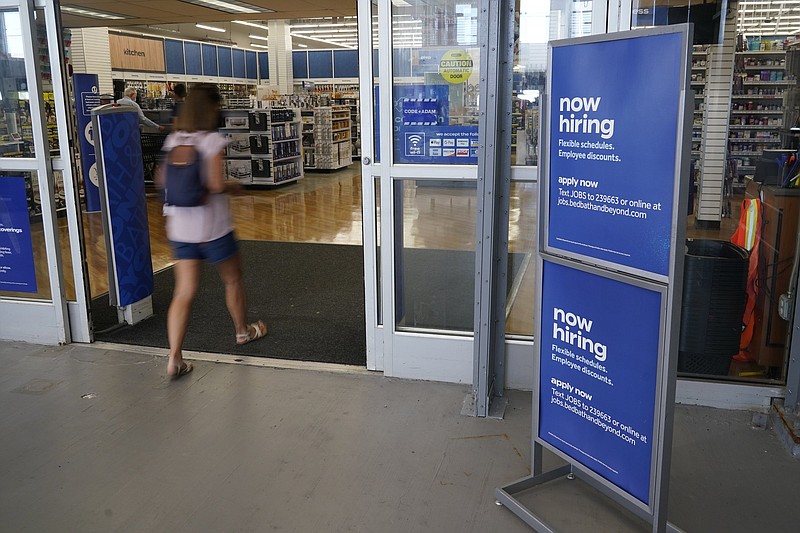WASHINGTON -- The number of Americans seeking unemployment aid fell last week to 498,000, the lowest point since the viral pandemic struck 14 months ago and a sign of the job market's growing strength as businesses reopen and consumers step up spending.
Thursday's report from the Labor Department showed that applications declined 92,000 from a revised 590,000 a week earlier. The number of weekly jobless claims -- a rough measure of the pace of layoffs -- has declined significantly from a peak of 900,000 in January as employers have ramped up hiring.
"In the last few weeks we've seen a pretty dramatic improvement in the claims data, and I think that does signal that there's been an acceleration in the labor market recovery in April," said Daniel Zhao, senior economist at the employment site Glassdoor.
At the same time, the pace of applications is still well above the roughly 230,000 level that prevailed before the viral outbreak tore through the economy in March of last year.
[CORONAVIRUS: Click here for our complete coverage » arkansasonline.com/coronavirus]
California, Florida, New York and Virginia had the biggest decreases in first-time unemployment claims last week. Kentucky, Minnesota and New Jersey were among the only states to post increases in weekly claims greater than 1,000.
As vaccinations have been more widely administered, restrictions on businesses have gradually lifted and consumers have become more willing to travel, shop and dine out. Stronger spending has increased hiring, slowed layoffs and accelerated growth. The economy grew last quarter at a vigorous 6.4% annual rate, with expectations that the current quarter will be even better.
The rapid turnaround has led many businesses, especially restaurants and others in the hospitality industry, to complain that they can't find enough workers. Some other employers are raising pay to attract applicants.
Pointing to the $300-a-week federal jobless check that was included in a $1.9 trillion rescue package enacted in March, some employers have complained that some unemployed people can receive more money from jobless aid than from a job.
Economic research has found that unemployment benefits can reduce the intensity with which workers search for jobs. But most studies find that the effect on the overall labor market is small, especially when unemployment is high.
And Zhao and other economists say there are other reasons that labor supply might be rebounding more slowly than demand. Many potential workers are juggling child care or other responsibilities at home; others remain cautious about the health risks of returning to in-person work.
[Video not showing up above? Click here to watch » https://www.youtube.com/watch?v=d2dLJso7mas]
"I think we will see labor supply improve pretty dramatically in the coming months as the pandemic abates," Zhao said.
Some states are ending a pandemic-era exemption to long-standing rules that required aid recipients to show that they were looking for jobs in order to keep receiving unemployment. That requirement was suspended during the pandemic but has recently been reinstated in Florida and New Hampshire.
In March, employers added nearly 1 million jobs, the most since August. Roughly the same number is expected to be reported today when the government issues the jobs report for April. Even so, the economy will still be more than 7 million jobs short of its pre-pandemic level.
"With jobless claims hitting a pandemic-era low, anticipation for the full jobs picture tomorrow mounts," Mike Loewengart, managing director of investment strategy at eTrade, said Thursday in comments emailed to The Washington Post. "Today's read is another proof point that we're one step closer to full economic recovery, sooner than some may have expected."
The government's report Thursday showed that about 16.2 million people were continuing to collect unemployment benefits in the week that ended April 17, down from 16.6 million in the previous week. That's a sign that some former recipients have found jobs.
Separate data Thursday showed productivity rebounded in the first quarter as the pace of output exceeded a pickup in hours worked. Nonfarm business labor productivity increased at a 5.4% annualized rate in the first quarter, the second fastest pace since 2009, after a revised 3.8% decline in the previous quarter. The gain in productivity helped restrain unit labor costs, which fell an annualized 0.3%.
As economic growth has accelerated, sales of vehicles and newly built homes have soared, manufacturing output has risen and Americans on average have increased their savings and wealth. In part, this is because of $1,400 stimulus checks that were distributed to most adults and in part because many affluent households have built up savings while working from home and have benefited from a surging stock market.
Information for this article was contributed by Christopher Rugaber of The Associated Press; by Ben Casselman of The New York Times; and by Taylor Telford of The Washington Post.

